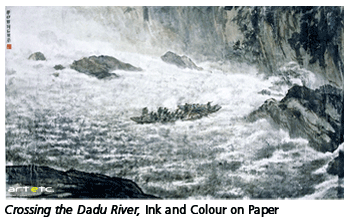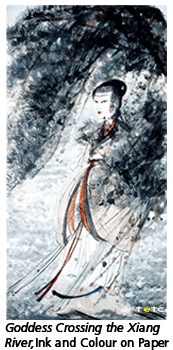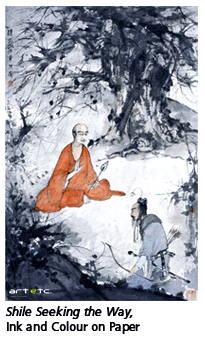- Publisher's Note
- Editorial
- Guerrilla Girls: The Masked Culture Jammers of the Art World
- Creating for Change: Creative Transformations in Willie Bester’s Art
- Radioactivists -The Mass Protest Through the Lens
- Broot Force
- Reza Aramesh: Action X, Denouncing!
- Revisiting Art Against Terrorism
- Outlining the Language of Dissent
- In the Summer of 1947
- Mapping the Conscience...
- 40s and Now: The Legacy of Protest in the Art of Bengal
- Two Poems
- The 'Best' Beast
- May 1968
- Transgressive Art as a Form of Protest
- Protest Art in China
- Provoke and Provoked: Ai Weiwei
- Personalities and Protest Art
- Occupy, Decolonize, Liberate, Unoccupy: Day 187
- Art Cries Out: The Website and Implications of Protest Art Across the World
- Reflections in the Magic Mirror: Andy Warhol and the American Dream
- Helmut Herzfeld: Photomontage Speaking the Language of Protests!
- When Protest Erupts into Imagery
- Ramkinkar Baij: An Indian Modernist from Bengal Revisited
- Searching and Finding Newer Frontiers
- Violence-Double Spread: From Private to the Public to the 'Life Systems'
- The Virasat-e-Khalsa: An Experiential Space
- Emile Gallé and Art Nouveau Glass
- Lekha Poddar: The Lady of the Arts
- CrossOver: Indo-Bangladesh Artists' Residency & Exhibition
- Interpreting Tagore
- Fu Baoshi Retrospective at The Metropolitan Museum of Art
- Random Strokes
- Sense and Sensibility
- Dragons Versus Snow Leopards
- What Happened and What's Forthcoming
- Art Events Kolkata, February – March 2012
- Mumbai Art Sighting
- Art Bengaluru
- Delhi Dias
- Musings from Chennai
- Preview, March, 2012 – April, 2012
- In the News, March 2012
- Cover
ART news & views
Fu Baoshi Retrospective at The Metropolitan Museum of Art
Issue No: 27 Month: 4 Year: 2012
 New York. The Metropolitan Museum of Art, New York in association with the Cleveland Museum of Art, Ohio and the Nanjing Museum, China, is presenting a retrospective exhibition of one of China’s most important Modern Artists of the 20th century, Fu Baoshi. The exhibition, Chinese Art in an Age of Revolution: Fu Baoshi (1904–1965), started on January 21 and continues till April 15, 2012. The show consists of 129 artworks and showcases an exclusive collection of 70 paintings, 11 Fan-Leaf paintings, and 20 seals amongst other works that have never been displayed outside Asia. Some of his finest works dating from the 1940’s period are on view, notable among them being The Poet Qu Yuan (1942), depicting the poet Qu Yuan (343–278 B.C.), Drunken Monk (1944), a portrait of Huaisu (725–ca. 799), and a Buddhist monk. His landscapes are suffused with layered applications of pale colours which create a brooding atmospheric effect. Through his subtle ink brush paintings he has demonstrated his intense feelings towards his native land. The grandeur of the mountains and the flow of river water have been deftly represented. Changsha: Poetic thoughts of Mao Zedong, Crossing the Dadu River are some among the numerous exquisite pieces which give an account of his love for the poetry of Mao Zedong and the natural scenery of China. At times the subject matter of his art reflects the propagandist vision of his socialist concern. But the highlight of the exhibition has been the assimilation of how Fu had successfully incorporated the study of Western Methods for developing a new nationalistic style where he romanticizes the vision of Communist domination. This exhibition is a tribute to the glorious forty year of his artistic career which established him as one of the great individualist Masters of Modern Art in China.
New York. The Metropolitan Museum of Art, New York in association with the Cleveland Museum of Art, Ohio and the Nanjing Museum, China, is presenting a retrospective exhibition of one of China’s most important Modern Artists of the 20th century, Fu Baoshi. The exhibition, Chinese Art in an Age of Revolution: Fu Baoshi (1904–1965), started on January 21 and continues till April 15, 2012. The show consists of 129 artworks and showcases an exclusive collection of 70 paintings, 11 Fan-Leaf paintings, and 20 seals amongst other works that have never been displayed outside Asia. Some of his finest works dating from the 1940’s period are on view, notable among them being The Poet Qu Yuan (1942), depicting the poet Qu Yuan (343–278 B.C.), Drunken Monk (1944), a portrait of Huaisu (725–ca. 799), and a Buddhist monk. His landscapes are suffused with layered applications of pale colours which create a brooding atmospheric effect. Through his subtle ink brush paintings he has demonstrated his intense feelings towards his native land. The grandeur of the mountains and the flow of river water have been deftly represented. Changsha: Poetic thoughts of Mao Zedong, Crossing the Dadu River are some among the numerous exquisite pieces which give an account of his love for the poetry of Mao Zedong and the natural scenery of China. At times the subject matter of his art reflects the propagandist vision of his socialist concern. But the highlight of the exhibition has been the assimilation of how Fu had successfully incorporated the study of Western Methods for developing a new nationalistic style where he romanticizes the vision of Communist domination. This exhibition is a tribute to the glorious forty year of his artistic career which established him as one of the great individualist Masters of Modern Art in China.

